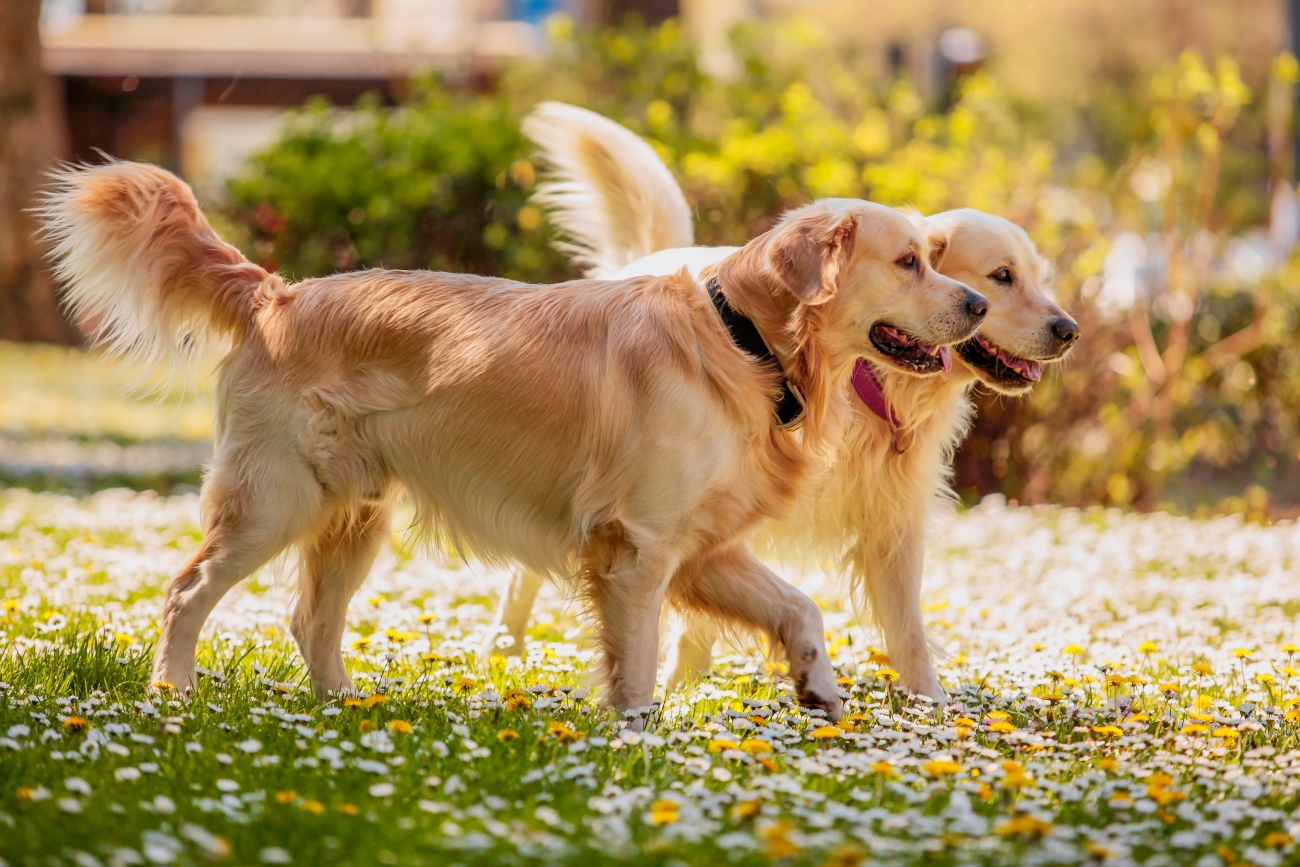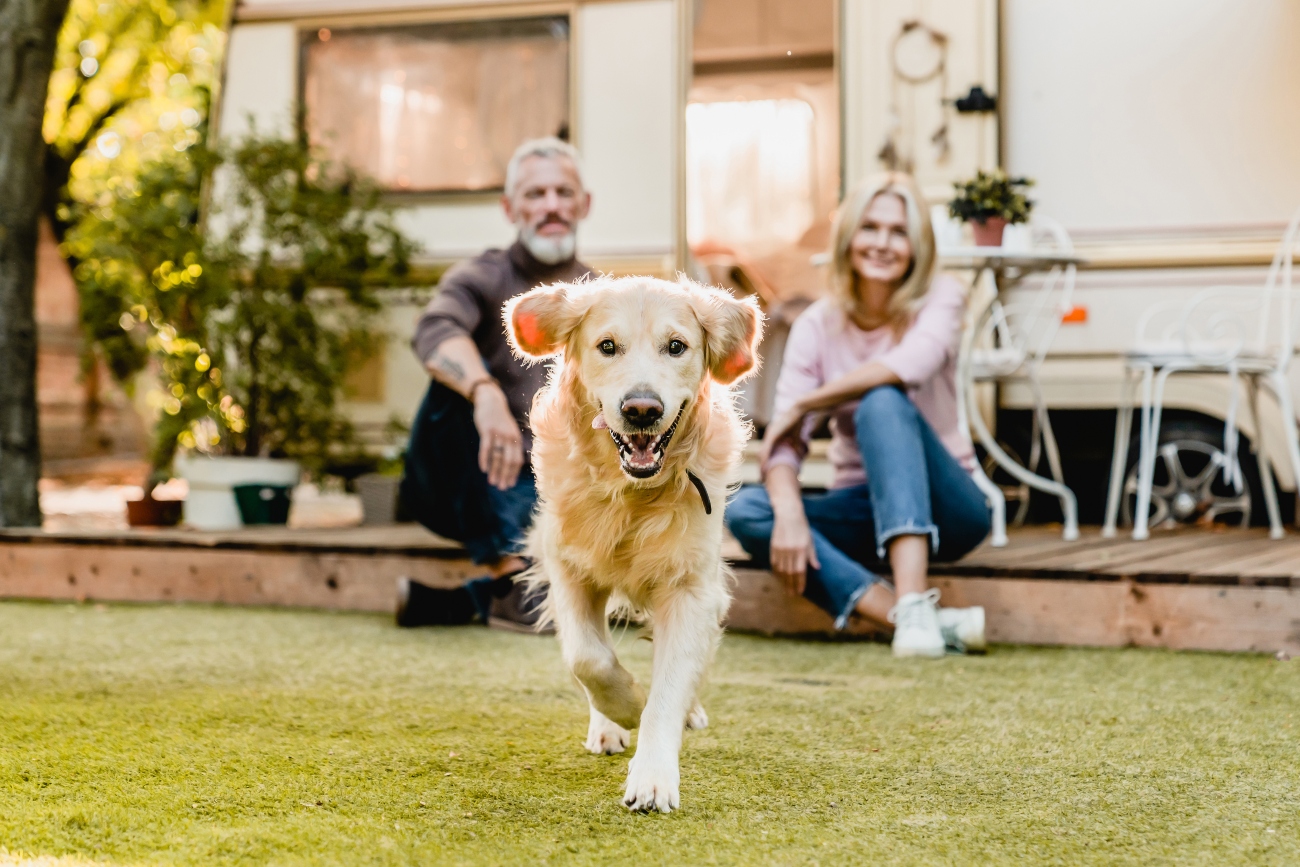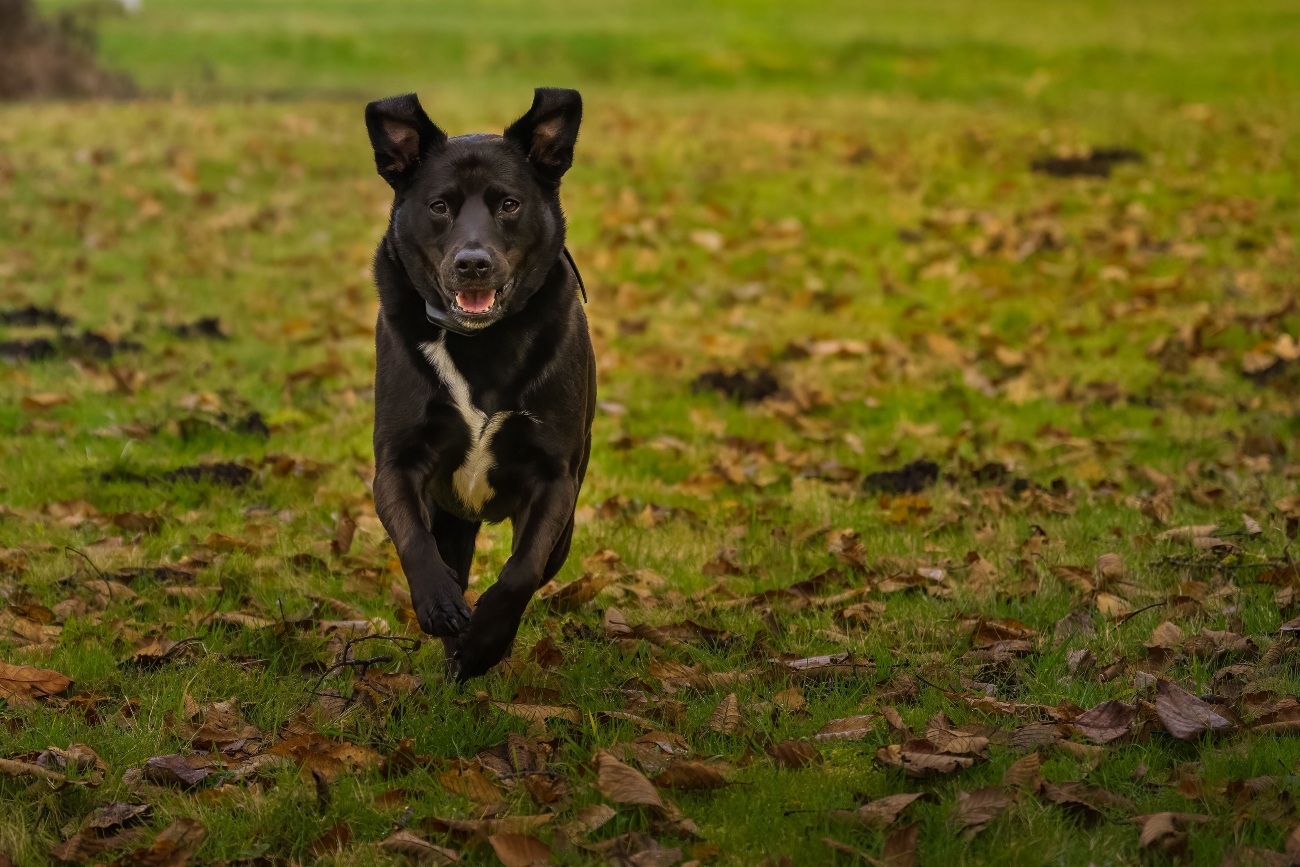
English Labs vs American Labs: what are the differences?
25th April, 2023
Is there really anything that differentiates these two types of Labrador? We take a look at their traits, origins and breed standards to find out.
Are you ready to welcome a loveable Labrador into your family? You’re not alone! According to the Kennel Club, they have reclaimed their throne as Britain’s favourite breed.
We’re sure you could pick one out of a line-up, right? But would you know whether it was an English or American Lab? Is there anything to distinguish between them or is it just where they were born?
Confused yet? Don’t worry – we’ve got the answers to everything you need to know!
We’ll delve into the details about American and English Labradors, comparing them in different categories.
You’ll also discover why insurance for older dogs is so important for your four-legged friend and which common health concerns to watch out for in your Lab.
Why do we distinguish between English Labs and American Labs?
A Lab is a Lab, isn’t it? Well, yes, but what we simply refer to as a Labrador in the UK is called the English Lab in the US. Why? There are some slight differences between the two.
Unless you have a lot of experience with the breed, you might find it hard to tell the difference, especially just by looking at them.
American Labs are often a little taller than their British counterparts and have a more muscular appearance. English Labradors are stockier and have a thicker tail.
Labs from the US are also known as working-type dogs while the English version is sometimes called a show Labrador. There are slight differences when it comes to personality, too.
Let’s compare the two, side by side, to make it easier to see how they differ.
| American Lab | English Lab | |
|
Height |
21.5-24.5” | 21.5-22.5” |
| Weight | 27-40 kg | 22.5-32 kg |
| Appearance | Athletic build, lean, long muzzle, narrow neck, thin coat, long legs | Thick neck, full chest, short body and legs, wide head and neck, thick coat |
| Temperament | Active, excitable, friendly and intelligent |
Calm, intelligent, friendly |
Despite their subtle differences, both Labs are prone to similar health risks, especially as they age. Protecting your pet with insurance for older dogs means they get the health care they need in an emergency.
English Labs vs American Labs: temperament
When it comes to these pooch’s personalities, there’s not a huge difference (they have more in common than they do distinguishing traits). But there are a few ways to tell them apart.
First, let’s look at the classic Lab characteristics that make them the lovable pets so many of us adore and that are apparent in both English and American versions:
- Sweet-natured
- Outgoing
- Friendly
- Eager to please
- Highly intelligent
- Active
The similarities stop there.
Yes, both breeds are high energy and love a good walk when they get the chance, but English Labradors are generally calmer than their excitable American cousins. In fact, US Labs can be a little stubborn and rather tenacious, so training early on is essential to a well-behaved pooch.
Having trouble with your senior Lab’s behaviour? Speak to your vet for help. They should be able to recommend a professional animal behaviourist to calm them down.
If negative personality changes are down to an underlying health issue, your insurance for older dogs could help towards the cost of treatment.
English Labs vs American Labs: appearance
The best way to tell these two apart is from their appearance, although they still look rather similar. Their colouring and general look is alike, but you can identify an American Lab by its athletic and muscular build.
US Labradors also have a narrow neck and long muzzle to fit their streamlined appearance. Their coat is thinner than the thick-furred British breed, who also have a wider tail.
Compared to American Labs, the English version is short and stocky, with a wide, thick tail to match. They also have a deeper chest and wide head and neck, giving them an overall chunkier appearance.
English Labs vs American Labs: breed standards
Despite the distinction between the two types of Lab, they both come under one breed standard, which they need to meet to compete in shows like Crufts or to breed.
English Labs vs American Labs: origins
Although the breed standards might not set them apart, their journey to be what they are today is quite different.
They both started out the same, evolving from their shared ancestor, the St. John’s Dog – a Canadian breed who worked with fishermen. When English nobles noticed their charming nature and hardworking attitude in the 1800s, they soon brought them back to British shores.
Once in Britain, breeders began to refine their traits and appearance, leading to two separate types of dog.
English Lab breeders focused on making their dogs show-ready, meaning they didn’t do a lot of work and naturally developed a stockier build.
Those who bred American Labradors focused their efforts on agility and work ethic, leading to a muscular physique and nimbleness. That doesn’t mean they can’t get into an accident though! So, don’t forget insurance for older dogs to protect them in case of injury.
English Labs vs American Labs: training
As both breeds are exceptionally intelligent, you probably think they’re a doddle to train. It’s an easy mistake to make!
What do we mean? Well, English Labs are calm and generally very receptive to training techniques, but the independent American Lab might have other ideas. Their strong will can sometimes mean they get distracted easily – they’d rather be on an adventure than learning a new trick!
So, if you own a Lab from across the pond, you might have more of a task on your hands when it comes to training – or retraining if you’re adopting an older canine.
Remember, even though your Lab is entering its golden years, it never stops learning. Sticking to a schedule keeps your pet alert and can help it stay in shape (older dogs can easily pile on a few pounds as they slow down).
We’ve got lots of training tips for your senior pooch elsewhere on our site. You can also use our 24-hour vet video service for advice on keeping your pet fit and health if you have insurance for older dogs with Petwise.
English Labs vs American Labs: health
Both breeds have an average lifespan of 10-12 years and are at risk of various health issues related to Labradors, which include:
- Heart disease
- Obesity
- Arthritis
- Progressive retinal atrophy
- Ear infections
We’ll go into more detail about these conditions later on, but it’s a good idea to ask if your potential pet has been screened for genetic health conditions that affect American and English Labs.
Why choose an English Lab?

You know you want to give an older Lab a good home but are now wondering if an English or American version is right for you.
Well, if you want a calm, intelligent and friendly pooch, you can’t go wrong with an English Lab! Yes, these Labrador puppies can be a bit of a handful, but by the time they reach adulthood, they’re generally well-behaved.
These UK hounds are also ideal if you don’t have a ton of time for training and are hoping for relaxing walkies with a pet who doesn’t keep pulling.
Their chilled nature doesn’t mean they don’t need a lot of exercise, though. English Labs are still high energy and need to keep their minds and bodies stimulated to keep them happy.
Pets who don’t get what they need can quickly develop health problems, which could see you whisking them to the vets for treatment and claiming on your insurance for older dogs.
Why choose an American Lab?
Are you looking for a canine companion to go on long walks in the country or work alongside you on your farm? Then an American Lab could be the perfect pooch.
With high stamina and never-ending energy, these dogs from the US belong to the physically elite and would likely win a few gold medals if the doggy Olympics ever came to town.
You’ll need to be an active individual and have plenty of time to dedicate to training. When left alone for long periods, American Labs get bored, and that’s when their attempts to entertain themselves might cause destruction.
Does an American Lab or an English Lab make a better pet?
There’s no simple answer when it comes to which Lab makes the best pet – it all depends on your lifestyle and what you’re looking for in a dog.
For families hoping for a friendly and calm pet, the English Lab might be the better choice, but if you love running or lead a very active, outdoor life, you might pick the American Labrador.
Remember, whichever breed you decide on, you’ll need to provide plenty of exercise opportunities, mental stimulation and protection with insurance for older dogs.
Caring for your Lab
Whether you opt for an activity-fuelled American Lab or a calm and cuddly English Lab, you’ll need to make sure you do everything right to care for them properly. So, what does your four-legged family member need to live a long and happy life in your household?
Food and nutrition
Your Lab has a massive appetite – they’re known for it! While it’s tempting to give into those puppy dog eyes staring up at you (yes, they still do this as a senior), it’s important not to give in, as Labradors are prone to obesity.
Speak to your vet about the right food and quantity for your pet. Ideally, a highly nutritious, top quality dog food is best to make sure it meets all its dietary needs.
If you do notice your Lab’s waistline quickly disappearing, they may need to diet. Has your vet suggested your golden oldie needs a special type of food? Don’t worry. Petwise insurance for older dogs comes with a senior food contribution to help with the higher costs.
Don’t forget to provide plenty of fresh, clean water to keep your Lab hydrated after all that running around.
Grooming
When it comes to looking after your Lab’s coat and skin, it’s best to only bathe them every 3 months or so (or when they’ve got particularly muddy). This helps maintain the natural oils, keeping their skin from drying out.
Their short hair means they’re pretty low maintenance as far as dogs go, but you’ll still need to brush their fur weekly to remove loose hair and dirt and spread those natural oils throughout the coat.
Stay on top of tooth brushing to avoid oral health issues (our insurance for older dogs provides dental cover as standard) and keep nails trimmed.
Wipe around inside those big floppy ears to prevent bacteria from causing an infection, too.
Exercise
We’ve already mentioned how energetic this breed is, so they need lots of opportunities to stretch their legs.
Labs are best suited to homes that have plenty of outdoor space to run around. They also enjoy a good walkie three times a day – try to make one of these a good few miles so they can really satisfy their need to run.
Common Labrador health conditions
Like with other pedigree pets, both American and English Labradors are at a higher risk of developing various medical issues, and the risk only increases with age.
The last thing you want is a poorly Lab, so knowing which problems they might face means you can get them help as soon as you spot something isn’t quite right.
Obesity
We all put on a few pounds as we age, and your Lab is just as likely to look a little rounder in its senior years.
When you adopt one of these adorable dogs, you’ll need to keep an eye on its calorie intake. These canines have a relentless appetite and will devour anything if given the opportunity, so it’s your job to keep to strict feeding guidelines.
Obesity can lead to a host of other health issues down the line, so how can you tell it’s time to cut back on the treats?
- Waist, ribs or spine aren’t visible
- Rounder face
- Not wanting to go out for walks
- Abdominal sagging
- Excessive panting
- Generally tired and lethargic
- Difficulty getting in and out of the car
Genes may be to blame for their obesity risk, but you can keep their weight under control. Speak to your vet if you spot any of the signs above. They’ll be able to recommend the right food and exercises to get them back in shape.
Don’t forget to use our vet video consultation service if you have insurance for older dogs with us and need some weight management advice.
Arthritis
Aches and pains are often part of the ageing process but wear and tear over the years means your Lab has a high chance of developing arthritis – an autoimmune condition that causes inflammation and pain.
The signs of arthritis in dogs include:
- Stiffness
- Limping
- Difficulty moving about
- Swollen joints
- Increased sleeping
- Reluctance to be cuddled and stroked
- A hunched back
Luckily, there are ways to manage arthritis and slow down its development.
If your Lab is overweight (which puts your pet at higher risk of arthritis), you can expect your vet to come up with a weight loss plan. They may also prescribe medication to help alleviate pain and inflammation.
Your Lab will need lifelong care and treatment for this chronic condition, but your insurance for older dogs can help with the costs.
Ear infections
Those big, floppy ears are certainly cute to look at, but they’re also the perfect breeding ground for a host of bacteria that can lead to ear infections. According to dog charity Blue Cross, you should take your Lab to the vet if you notice:
- Discharge from the ears
- Pain around ears when touched
- Ear swelling
- Unpleasant smell from the ears
- Shaking their head
- Itchy ears
- Holding their head to one side
Apart from bacteria, other ear infection causes include allergies, mites and foreign objects getting stuck inside. Once your vet has diagnosed the infection and what’s behind it, they’ll be able to prescribe the right treatment, which usually involves drops and steroids. In extreme cases, your dog might need surgery.
Heart disease
Another medical concern that’s common in Labs is heart disease. Sadly, many owners don’t realise their pet is suffering before it’s too late, so keep a close eye on your beloved dog for the following:
- Lethargy
- Fainting and collapsing
- Coughing a lot
- Eating less than normal
- Trouble breathing
- Rapid weight loss or gain
- Distended abdomen
Of course, a lot of these symptoms also point to other health issues, some less serious than heart disease, but that doesn’t mean you should put the vet visit on hold.
Finding out what’s wrong with your senior pet in the early stages of an illness can improve its chances of recovery. And if you're worried about the treatment costs, don’t be – your insurance for older dogs is there to support you financially in a medical emergency.
Progressive retinal atrophy
This hereditary condition is common in Labs and often first appears around 7 to 8 years of age. Dogs with progressive retinal atrophy tend to lose their night vision first before gradually losing their vision during the day, too. Most affected pets will end up totally blind.
Watch your dog for signs of the disease, like:
- Cloudy looking eyes
- A sheen over the eyes
- Grey eyes
- Dilated pupils
- Bumping into furniture
- Reluctance to go up and down stairs
Thankfully, canines have plenty of other superior senses that help them navigate the world even after they go completely blind. So, with a little help from you, they can still live a long and happy life.
Find Labrador insurance for older dogs

As dogs age, they need you to look out for them more than ever. They’re susceptible to more health risks and also have a higher chance of getting into an accident, which means a comprehensive insurance plan that protects them in an emergency is an absolute must.
Why choose Petwise to cover your Lab?
We believe every dog deserves the best, no matter its age. That's why we offer a range of lifetime policies specifically aimed at senior pets to make sure they get the healthcare they need to enjoy their golden years to the fullest.
All our pet plans come with unlimited access to our 24-hour vet video consultation service and dental cover as standard.